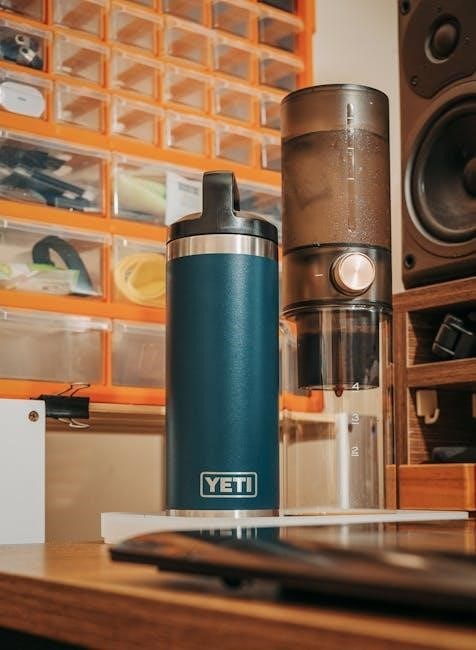Unboxing and Physical Setup of the Blue Yeti
Welcome to your Blue Yeti setup! Carefully unbox and inspect all components, including the microphone, stand, USB cable, and user manual. Rotate the mic so the Blue logo faces you for easy access to controls. Place the stand on a stable surface and adjust the height as needed. For optimal positioning, consider using a boom arm for flexibility. Plug in the USB cable to your computer and ensure the microphone is securely mounted. This setup ensures you’re ready to start recording with clarity and precision.
1.1. Understanding the Components of the Blue Yeti
The Blue Yeti includes a high-quality condenser microphone, a sturdy metal stand, a USB cable for connectivity, and a headphone jack for real-time monitoring. The microphone features a front-facing capsule with a cardioid polar pattern by default. On the back, you’ll find a gain control knob and a multi-pattern selector for switching between recording modes. The base includes a 3.5mm headphone jack for zero-latency listening and a mute button for quick audio cutoff. These components work together to deliver professional-grade sound and versatility.
1.2. Mounting the Microphone on a Stand
Mounting the Blue Yeti on its stand ensures stability and proper positioning. Attach the microphone to the stand by aligning the threaded socket on the mic’s base with the stand’s screw. Tighten securely to prevent wobbling. Position the Blue Yeti so the logo faces forward and the capsule is directed toward your sound source. Adjust the stand height to suit your recording setup, ensuring the mic is at chest or head level for optimal audio capture.
1.3. Positioning the Blue Yeti for Optimal Recording
Position the Blue Yeti 6-8 inches away from your sound source, such as your mouth, to capture clear audio. Angle the microphone slightly upward to align with your voice. Place the mic on a stable stand at chest or head level to reduce vibrations. Use a pop filter to minimize plosives. Ensure the room is acoustically treated to avoid echo and background noise. This setup ensures professional-grade sound quality for podcasts, voice-overs, or music recordings.
Understanding the Blue Yeti’s Recording Modes
The Blue Yeti offers four versatile recording modes: cardioid, stereo, omnidirectional, and bidirectional. Each mode serves different purposes, from isolating your voice to capturing wide soundscapes. Cardioid mode excels for voice-overs, focusing on the speaker while minimizing background noise. Stereo mode is ideal for capturing a wide soundstage, perfect for live performances or interviews. Omnidirectional mode picks up sound from all directions, great for group conversations, while bidirectional mode captures sound from the front and back, ideal for two-person interviews. Experiment with these modes to find the best fit for your recording needs.
2.1. Cardioid Mode for Voice Recording
Cardioid mode is ideal for voice recording, isolating your voice while minimizing background noise. The microphone picks up sound from the front and rejects it from the sides and rear. Perfect for podcasting, voice-overs, or streaming, this mode ensures a clear, focused sound. Activate it by rotating the pattern selector to the cardioid symbol. It’s great for solo recordings, delivering professional-quality audio with reduced ambient interference.
2.2. Stereo Mode for Wide-Angle Recordings
Stereo mode captures a wide soundstage, ideal for recording two voices, interviews, or ambient sounds. It uses both capsules to create a rich, immersive audio experience. Activate it by selecting the stereo symbol on the pattern selector. This mode is perfect for capturing a broad audio landscape, making it great for live performances, duets, or field recordings. It ensures a balanced and expansive sound, ideal for dynamic or multi-instrumental setups.
2.3. Omnidirectional Mode for 360-Degree Pickup
Omnidirectional Mode captures sound from all directions, ideal for group recordings or ambient audio. Activate it by selecting the circular pattern on the mic. This mode is perfect for multi-person interviews, meetings, or live performances, ensuring everyone’s voice is picked up evenly. It’s also great for capturing room ambiance or outdoor recordings. Position the mic centrally for balanced audio, and consider using a stand or boom arm for optimal placement. This mode offers a natural, immersive sound experience.
2.4. Bidirectional Mode for Two-Person Recordings
Bidirectional Mode captures sound from both the front and back, ideal for two-person interviews or dual recordings. Activate it by selecting the figure-eight pattern. Position the mic between two speakers for balanced pickup. This mode reduces side noise and delivers clear, focused audio for professional-sounding podcasts or interviews. Ensure the mic is centered and angled slightly toward each speaker for optimal results.
Connecting the Blue Yeti to Your Computer
Plug the Blue Yeti into your computer’s USB port using the provided cable. Install any necessary drivers automatically detected by your system. Open recording software and ensure the Blue Yeti is selected as the input device for a seamless connection.
3.1. USB Connection Setup
Connect the Blue Yeti to your computer using the provided USB cable. Plug one end into the microphone’s base and the other into your computer’s USB port. Allow your system to automatically detect and install the necessary drivers. Once connected, open your recording software and select the Blue Yeti as the input device in the audio settings. This ensures a direct and stable connection for high-quality audio capture.
3.2. Using an Audio Interface with the Blue Yeti
For enhanced sound quality, connect the Blue Yeti to an audio interface using an XLR cable. Plug the XLR cable into the Yeti’s base and the other end into the interface’s input. This setup bypasses the USB connection, offering lower latency and better preamp control. Many interfaces provide phantom power, which the Yeti doesn’t require, so ensure it’s disabled. This method is ideal for professional recordings, allowing for higher fidelity and more precise audio adjustments.
Adjusting Gain and Headphone Volume
Turn the gain knob to set the optimal level for your voice, ensuring it’s loud but free from distortion. Use the headphone volume knob for zero-latency monitoring.
4.1. Setting the Correct Gain for Your Voice
Start with the gain knob at a low setting and gradually increase it while speaking into the microphone. Aim for peak levels between -6 to -3 dB to ensure your voice is clear and strong without distortion. Position the mic appropriately—about 6-8 inches away from your mouth—and adjust based on the recording environment. Use the headphone jack for real-time monitoring to fine-tune the gain accurately, ensuring optimal sound quality for your recordings.
4;2. Adjusting the Headphone Volume for Zero-Latency Monitoring
Plug your headphones into the 3.5mm jack on the underside of the Blue Yeti. Use the headphone volume knob to adjust the monitoring level. Start with a low setting and increase as needed while speaking. This direct monitoring allows you to hear your voice without audio interface delays. Ensure the volume is comfortable and clear, avoiding distortion. Proper headphone adjustment ensures you can accurately assess your recording quality in real time.
Reducing Background Noise and Echo
Minimize background noise by positioning the Blue Yeti away from noisy areas. Use a pop filter to reduce plosives and ensure the room is acoustically treated.
5.1. Using a Pop Filter to Minimize Plosives
A pop filter reduces harsh plosive sounds like “p” and “t” by diffusing airflow from your mouth. Place it 6-8 inches from the Blue Yeti, positioning it between your mouth and the microphone. This simple accessory significantly improves audio clarity. You can purchase a professional pop filter or create a DIY version using nylon mesh or metal. It ensures smoother recordings and prevents distortion caused by strong consonants.
5.2. Acoustic Treatment for Your Recording Space
Acoustic treatment minimizes echo and reverberation in your recording space. Use acoustic panels or soundproof blankets on walls and ceilings to absorb sound reflections. Place the Blue Yeti away from walls to reduce echo. Add bass traps in corners to control low-frequency buildup. A well-treated room ensures your recordings sound professional, with clear audio free from unwanted reverberations. This step is crucial for achieving high-quality sound with your Blue Yeti microphone.

Recording Software Setup and Configuration
Acoustic treatment minimizes echo and reverberation in your recording space. Use acoustic panels or soundproof blankets on walls and ceilings to absorb sound reflections. Place the Blue Yeti away from walls to reduce echo. Add bass traps in corners to control low-frequency buildup. A well-treated room ensures your recordings sound professional, with clear audio free from unwanted reverberations. This step is crucial for achieving high-quality sound with your Blue Yeti microphone.
6.1. Choosing the Right DAW for Your Needs
Selecting the right Digital Audio Workstation (DAW) is crucial for recording with your Blue Yeti. Popular options include Audacity (free and great for beginners), GarageBand (ideal for Mac users), and Logic Pro X or Adobe Audition for advanced users. Consider your skill level, budget, and specific recording needs. Ensure the DAW supports your Blue Yeti by checking compatibility settings. Experiment with free trials to find the best fit for your workflow and audio goals.
6.2. Configuring the Blue Yeti in Your Recording Software
Once your DAW is installed, open the audio settings and select the Blue Yeti as your input device. In the recording tab, right-click on the microphone and choose Properties to access the enhancement tab. Ensure the correct microphone is selected and adjust the gain levels appropriately. Test your setup by recording a short audio clip to verify sound quality. Proper configuration ensures optimal performance and clear recordings.

Optimizing Your Recording Environment
Position the Blue Yeti away from walls to minimize echo. Use a pop filter to reduce plosives and ensure the room is acoustically treated for clearer sound.
7.1. Positioning the Microphone in the Room
Position the Blue Yeti 6-8 inches from your source, slightly above eye level, to capture clear audio. Avoid pointing it directly at your mouth to reduce plosives. Place the mic in the center of the room or away from walls to minimize echo. Experiment with angles to find the sweet spot for your voice. This setup ensures balanced sound pickup and reduces background noise for professional-quality recordings.
7.2. Minimizing Echo and Reverberation
To reduce echo and reverberation, ensure your recording space isn’t overly empty, as bare walls and floors reflect sound; Position the Blue Yeti away from walls and use a pop filter to minimize plosives. Consider adding rugs, curtains, or acoustic panels to absorb sound waves. Close doors to external spaces to block outside noise. These adjustments will create a more controlled acoustic environment, resulting in clearer and more professional recordings.
Troubleshooting Common Issues
Common issues include low volume, background noise, or no sound output. Check USB connections, ensure the mic is selected in settings, and restart your device. Adjust gain settings and reduce environmental noise. If problems persist, consult the user manual or contact support for further assistance.
8.1. Fixing Low Volume or No Sound Output
If experiencing low volume or no sound, first ensure the Blue Yeti is properly connected to your computer via USB. Check that the microphone is selected as the input device in your recording software or system settings. Restart your computer and microphone to reset the connection. Adjust the gain knob on the Yeti to an optimal level, avoiding distortion. If issues persist, check for updated drivers or contact Blue support for assistance.
8.2. Reducing Distortion and Background Hum
To minimize distortion and background hum, ensure the Blue Yeti is positioned away from direct noise sources like fans or electronics. Lower the gain knob to prevent overloading the signal; Use a shock mount to reduce vibrations and invest in a pop filter to soften harsh sounds. Ensure the USB connection is secure and free from interference. Record in a quiet room with acoustic treatment to further reduce ambient noise for a cleaner audio output.

Best Practices for Recording
Speak clearly, maintain optimal distance from the mic, and use a pop filter to reduce plosives. Record in a quiet room and position the Blue Yeti correctly. Save and export your recordings in high-quality formats for professional results.
9.1. Speaking Techniques for Clear Audio
To achieve clear audio, maintain an optimal distance from the Blue Yeti, typically 6-8 inches. Speak at a consistent volume and enunciate clearly. Avoid plosive sounds by positioning the mic slightly off-center. Breathe naturally to prevent harsh tones. Keep your voice steady and avoid sudden movements. These techniques ensure your recordings are crisp, professional, and free from distortion.
9.2. Saving and Exporting Your Recordings
After recording, stop the session and save your file in a preferred format, such as WAV or MP3. Choose a clear file name for easy organization. Select the correct export settings in your DAW to maintain audio quality. Export the file to a dedicated folder for your projects. Finally, back up your recordings to an external drive or cloud storage to ensure your work is safe and accessible for future use.

Advanced Techniques and Accessories
Elevate your Blue Yeti experience with advanced techniques and accessories. Use a shock mount to reduce vibrations and an external preamp for enhanced sound quality. Experiment with windscreens and pop filters to minimize plosives and hum. Consider a boom arm for flexible positioning and invest in acoustic panels for a cleaner recording environment. These upgrades and methods will take your audio to the next level.
10.1. Using a Shock Mount for Reduced Vibration
A shock mount is essential for minimizing vibrations that can interfere with your recordings. It isolates the Blue Yeti from desk bumps or footsteps, ensuring cleaner audio. To install, attach the shock mount to your microphone stand and gently place the mic into the mount. Tighten the screws securely but avoid over-tightening, as this could damage the microphone. Position the mic correctly, and you’ll notice a significant reduction in unwanted vibrations during recording sessions.
10.2. Adding an External Preamp for Better Sound Quality
An external preamp enhances your Blue Yeti’s sound quality by boosting the microphone signal before it reaches your recording device. Connect the Yeti to the preamp using an XLR or TRS cable, then link the preamp to your audio interface or computer. This setup reduces noise and ensures a cleaner signal. Adjust the preamp’s gain to optimize your audio levels, resulting in clearer and more professional-sounding recordings with minimal distortion or hum.

Maintenance and Care of the Blue Yeti
Regularly clean the grille with a soft cloth and avoid harsh chemicals. Store the microphone in its original box or a protective case when not in use. Handle the Blue Yeti gently to prevent damage and keep it away from moisture and direct sunlight for optimal performance and longevity.
11.1. Cleaning the Microphone Grille
Clean the Blue Yeti’s grille gently with a soft, dry cloth to remove dust and debris. Avoid harsh chemicals or abrasive materials that could damage the metal mesh. For stubborn stains, dampen the cloth slightly but ensure no moisture reaches the internal components. Regular cleaning maintains sound quality and prevents dirt buildup.
Use compressed air cautiously to blow away loose particles from the grille. Handle the microphone with care to avoid bending or warping the grille, which can affect its performance. Cleaning should be done after each recording session for optimal results.
11.2. Storing the Blue Yeti Properly
Store the Blue Yeti in its original box or a protective case to prevent scratches and dust. Place it in a dry, cool environment away from direct sunlight. Avoid exposure to extreme temperatures or humidity, as this can damage the internal components. Keep the microphone upright to prevent dust from settling on the grille. For added protection, use a soft pouch or wrap it in a cloth. Proper storage ensures longevity and maintains optimal performance.
